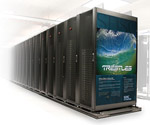Supercomputer Trestles launched
By By Jan Zverina, Warren R Froelich | 01 Mar 2011
The San Diego Supercomputer Center (SDSC) at the University of California, San Diego, has deployed a new high-performance computer (HPC) called Trestles, the result of a $2.8 million award from the National Science Foundation (NSF).
 Trestles is available to users of the TeraGrid, the nation's largest open-access scientific discovery infrastructure. The system is among the five largest in the TeraGrid repertoire, with 10,368 processor cores, a peak speed of 100 teraflop/s, 20 terabytes memory, and 38 terabytes of flash memory. One teraflop (TF) equals a trillion calculations per second, while one terabyte (TB) equals one trillion bytes of information.
Trestles is available to users of the TeraGrid, the nation's largest open-access scientific discovery infrastructure. The system is among the five largest in the TeraGrid repertoire, with 10,368 processor cores, a peak speed of 100 teraflop/s, 20 terabytes memory, and 38 terabytes of flash memory. One teraflop (TF) equals a trillion calculations per second, while one terabyte (TB) equals one trillion bytes of information.
''Trestles is appropriately named because it will serve as a bridge between SDSC's unique, data-intensive resources available to a wide community of users both now and into the future,'' said Michael Norman, SDSC's director.
Configured by SDSC and Appro, Trestles is based on quad-socket, 8-core AMD Magny-Cours compute nodes connected via a QDR InfiniBand fabric. Each of its 324 nodes has 32 cores, 64 gigabytes (GB) of memory, and 120 GB of flash memory. Debuting at #111 on the top 500 list of supercomputers in the latest ranking, Trestles will work with and span the deployments of SDSC's recently introduced Dash system and a larger data-intensive system named Gordon, to become operational in late 2011.
All three SDSC systems employ flash-based memory, which is common in much smaller devices such as mobile phones and laptop computers but unique for supercomputers, which generally use slower spinning disk technology. ''UCSD and SDSC are pioneering the use of flash in high-performance computing,'' said Allan Snavely, associate director of SDSC and a co-PI for the new system. ''Flash disks read data as much as 100 times faster than spinning disk, write data faster, and are more energy-efficient and reliable.''
''Trestles, as well as Dash and Gordon, were designed with one goal in mind, and that is to enable as much productive science as possible as we enter a data-intensive era of computing,'' said Richard Moore, SDSC's deputy director and co-PI. ''Today's researchers are faced with sifting through tremendous amounts of digitally based data, and such data-intensive resources will give them the tools they need to do so.''






























